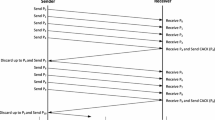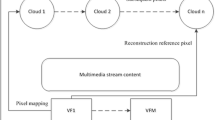Abstract
Video streaming has become one of the most popular networked applications and, with the increased bandwidth and computation power of mobile devices, anywhere and anytime streaming has become a reality. Unfortunately, it remains a challenging task to compress high-quality video in real-time in such devices given the excessive computation and energy demands of compression. On the other hand, transmitting the raw video is simply unaffordable from both energy and bandwidth perspective. In this paper, we propose DualEMC, a novel cloud-assisted video compression mechanism for mobile devices. DualEMC leverages the abundant cloud server resources for motion estimation (ME), which is known to be the most computation-intensive step in video compression, accounting for over 90 % of the computation time. With DualEMC, a mobile device selects and uploads only the key information of each picture frame to cloud servers for mesh-based ME, eliminating most of the local computation operations. We develop smart algorithms to identify the key mesh nodes, resulting in minimum distortion and data volume for uploading. Our simulation results demonstrate that DualEMC saves almost 30 % energy for video compression and transmission.




Similar content being viewed by others
References
Altunbasak, Y., & Tekalp, A. M. (1997). Occlusion-adaptive, content-based mesh design and forward tracking. IEEE Transactions on Image Processing, 6(9), 1270–1280.
Amazon. Amazon High Performance Computing (HPC). http://aws.amazon.com/hpc-applications/.
Armbrust, M., Fox, A., Griffith, R., Joseph, A. D., Katz, R. H., Konwinski, A., Lee, G., Patterson, D. A., Rabkin, A., Stoica, I., et al. (2009). Above the clouds: A berkeley view of cloud computing. Technical Report UCB/EECS-2009-28, EECS Department, University of California, Berkeley.
Badawy, W., & Bayoumi, M. (2002). A multiplication-free algorithm and a parallel architecture for affine transformation. The Journal of VLSI Signal Processing, 31(2), 173–184.
Badawy, W., & Bayoumi, M. A. (2002). A low power VLSI architecture for mesh-based video motion tracking. IEEE Transactions on Circuits and Systems II Analog and Digital Signal Processing, 49(7), 488–504.
Bahari, A., Arslan, T., & Erdogan, A. T. (2009). Low-power H. 264 video compression architectures for mobile communication. IEEE Transactions on Circuits and Systems for Video Technology, 19(9), 1251–1261.
Balasubramanian, N., Balasubramanian, A., & Venkataramani, A. (2009). Energy consumption in mobile phones: a measurement study and implications for network applications. In Proceedings of the 9th ACM SIGCOMM conference on Internet measurement conference, (pp. 280–293).
Cheng, H. P., Shen, Y. C., Wu, J. L., & Aizawa, K. (2011). High efficient distributed video coding with parallelized design for cloud computing. In Proceedings of the 19th ACM international conference on Multimedia, (pp. 1257–1260).
Dudon, M., Avaro, O., & Roux, C. (1997). Triangular active mesh for motion estimation. Signal Processing Image Communication, 10, 21–41.
Huang, Z., Mei, C., Li, L. E., & Woo, T. (2011). CloudStream: Delivering high-quality streaming videos through a cloud-based SVC proxy. In INFOCOM, 2011 Proceedings IEEE, (pp. 201–205).
Intel. Intel Performance Counter Monitor. http://software.intel.com/en-us/articles/intel-performance-counter-monitor/.
Jackson, E. S., & Peplow, R. (2003). Video Compression System for Mobile Devices. RN, 2(2).
Kubasov, D., & Guillemot, C. (2006). Mesh-based motion-compensated interpolation for side information extraction in distributed video coding. IEEE International Conference on Image Processing, 2006, 261–264.
Lai, Y. X., Lai, C. F., Hu, C. C., Chao, H. C., & Huang, Y. M. (2011). A personalized mobile IPTV system with seamless video reconstruction algorithm in cloud networks. International Journal of Communication Systems, 24(10), 1375–1387.
Lin, C. H., Shieh, C. K., Ke, C. H., Chilamkurti, N. K., & Zeadally, S. (2009). An adaptive cross-layer mapping algorithm for MPEG-4 video transmission over IEEE 802.11e WLAN. Telecommunication Systems, 42(3—-4), 223–234.
Liu, F., Shen, S., Li, B., Li, B., Yin, H., & Li, S. (2011). Novasky: Cinematic-quality VoD in a P2P storage cloud. INFOCOM, 2011 Proceedings IEEE, (pp. 936–944).
Miao, D., Zhu, W., Luo, C., & Chen, C.W. (2011). Resource allocation for cloud-based free viewpoint video rendering for mobile phones. Proceedings of the 19th ACM international conference on Multimedia, (pp. 1237–1240).
Nakaya, Y., & Harashima, H. (1994). Motion compensation based on spatial transformations. IEEE Transactions on Circuits and Systems for Video Technology, 4(3), 339–356.
Peixoto, E., de Queiroz, R. L., & Mukherjee, D. (2008). Mobile video communications using a Wyner-Ziv transcoder. Symposium on Electronic Imaging, Visual Communications and Image Processing (SPIE), San Jose, CA, USA.
Sayed, M., & Badawy, W. (2004). A novel motion estimation method for mesh-based video motion tracking. In IEEE International Conference on Acoustics, Speech, and Signal Processing, 2004. Proceedings (ICASSP’04), volume 3, (pp. iii-337).
Shamir, A. (2008). A survey on mesh segmentation techniques. Computer graphics forum, 27(6), 1539–1556.
Singh, K., & Davids, C. (2011). Flash-based audio and video communication in the cloud. Arxiv preprint arXiv:1107.0011.
SourceForge. Java H.264 Encoder. http://sourceforge.net/projects/h264avcjavaenco/.
Sullivan, G. J., & Wiegand, T. (2005). Video compression-from concepts to the H. 264/AVC standard. Proceedings of the IEEE, 93(1), 18–31.
Valette, S., Magnin, I., & Prost, R. R. (2004). Mesh-based video objects tracking combining motion and luminance discontinuities criteria. Signal processing, 84(7), 1213–1224.
Wang, T., & Ostermann, J. (1988). Evaluation of mesh-based motion estimation in H. 263-like coders. IEEE Transactions on Circuits and Systems for Video Technology, 8(3), 243–252.
Wang, Y., & Lee, O. (1994). Active mesh-a feature seeking and tracking image sequence representation scheme. IEEE Transactions on Image Processing, 3(5), 610–624.
Wang, Y., Lee, O., & Vetro, A. (1996). Use of two-dimensional deformable mesh structures for video coding, part II: The analysis problem and a region-based coder employing an active mesh representation. IEEE Transactions on circuits and systems for video technology, 6(6), 647–659.
Wang, Y., Ostermann, J., & Zhang, Y. Q. (2002). Video processing and communications (Vol. 1). Upper Saddle River: Prentice Hall.
Wu, Y., Wu, C., Li, B., Qiu, X., & Lau, F. (2011). CloudMedia: When cloud on demand meets video on demand. 2011 31st International Conference on Distributed Computing Systems (ICDCS), (pp. 268–277).
YouTube. YouTube Statistics. http://www.youtube.com/t/press_statistics.
Yuan, W., & Nahrstedt, K. (2006). Energy-efficient CPU scheduling for multimedia applications. ACM Transactions on Computer Systems (TOCS), 24(3), 292–331.
Author information
Authors and Affiliations
Corresponding author
Rights and permissions
About this article
Cite this article
Zhao, Y., Zhang, L., Ma, X. et al. DualEMC: energy efficient mobile multimedia communication with cloud. Telecommun Syst 60, 85–94 (2015). https://doi.org/10.1007/s11235-014-9923-2
Published:
Issue Date:
DOI: https://doi.org/10.1007/s11235-014-9923-2




